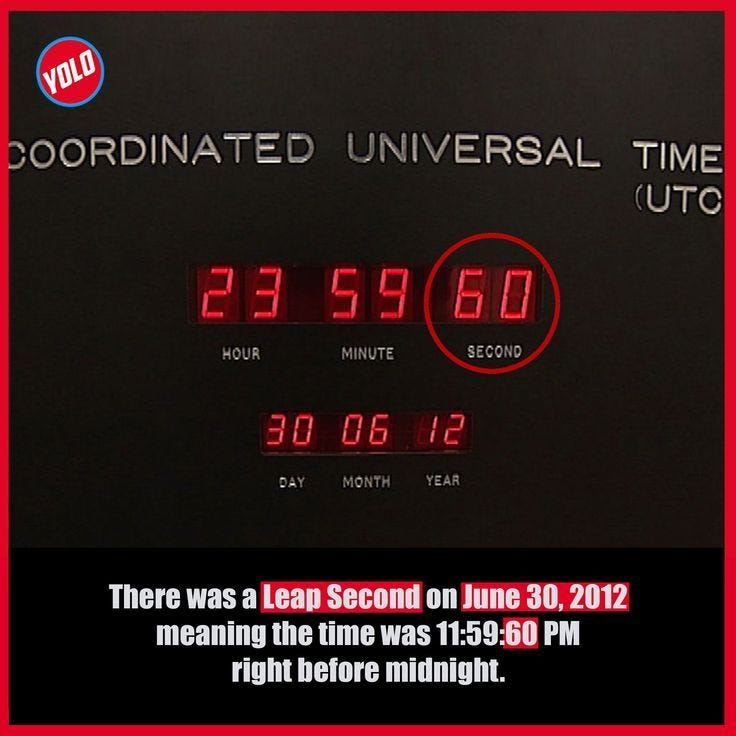How earth's rotation caused Software Systems to go down?
Every second counts...sometimes!
👋 Hey there, fellow tech enthusiasts, professionals, and wanderers of the digital realm! 🚀
I am Gourav. I write about Engineering, Productivity, Thought Leadership, and the Mysteries of the mind!
Welcome back and Happy New Year!
(I clicked that pic on the New Year celebration at Space Needle, Seattle, Washington!)
Today, I am going to dive into an interesting puzzle of how many software systems crashed simultaneously; share a thought-provoking story, and expose what I am addicted to!
Your engagement is what makes this community vibrant, so feel free to hit reply and share your thoughts, feedback, and ideas, or even just to say hello!
Today at a Glance
Survey: It’s not your fault!
A Thought-provoking Quote
Main Topic: A ‘time’ when multiple Software Systems crashed around the world
What am I addicted to?
Survey: It’s not your fault!
Despite having so many resources to learn, cracking a new skill or gathering life-changing knowledge isn’t simple.
It's not your fault that traditional learning methods demand time we don't have. Books are a time-consuming voyage, and audiobooks lack that personal touch.
Now, there are two main ways to learn.
1/ Learn by making mistakes yourselves;
2/ Learn through the wisdom gleaned from the mistakes of others
Fill out this free survey in under 30 seconds, to help me understand the topic that you would like to learn and I will share my long-gathered wisdom via a course!
As a token of appreciation, you will enjoy an exclusive 20% discount when our course flings open its doors to enrollment.
Seize the opportunity to transform your future—let's make your career goals a reality! 🚀
Thought-provoking Quote
Men are not prisoners of fate, but only prisoners of their own minds
— Franklin Roosevelt, legendary US President
This interesting story would help you retain this deeply:
A merchant traveling with his three camels stopped at an inn at night and had only two ropes to tie them to the tavern.
After tying two camels, as he fell short of the rope, he got a brilliant idea.
He simply pretended to put a noose around the third camel’s neck and then attach that virtual rope to a peg.
Thinking it was tied, the third camel sat down timidly, like the others.
In the morning, when they had to leave, he untied two camels, but the third one refused to budge…
…because it was under the impression that it was also tied, the merchant had to do a virtual or fake untie to make the third camel move.
Like the camel, many times, we involuntarily tie ourselves to false beliefs created by our own minds.
We must, therefore, crush those briefs like “I am a failure”, and “Success isn’t for me” and rather train our minds to think positively.
A story about a ‘time’ when many Software Systems around the world crashed at the same time…
On the night of June 30th to July 1st, 2012, many online services and systems around the world crashed simultaneously.
The servers locked up and stopped responding.
Many airlines could not process any reservations or online check-in for several hours.
So, what happened here?
Well, A Leap second happened.
Source of picture: https://in.pinterest.com/pin/742249582348637613/
Before we can understand what happened, we need to understand what is leap second.
In short,
Leap seconds are inserted in UTC to keep UTC and GMT from drifting apart.
GMT, UTC…leap seconds…what the heck…
what is even a ‘second’? How is time calculated?
Explain ‘Time’ like I’m a novice!
Don’t worry, let’s understand it in a very simple manner.
The notion of time is related to the duration it takes for Earth to revolve around the sun.
GMT: stands for Greenwich Mean Time, the mean solar time at the Royal Observatory in Greenwich on the south bank in Eastern London, UK. When the sun is at its highest point exactly above Greenwich, it is 12 noon GMT. Except: The Earth spins slightly unevenly, so 12 noon is defined as the annual average, the mean of when the sun is at its highest, its culmination.
So, GMT is based on astronomical observations.
Atomic Clocks and Time: This is the international way of defining time. Internal Atomic Time (TAI) is based on the caesium atom’s resonant frequency. So, put simply, we count the oscillations in this atom to calculate time.
1 day = 20 x 60 x 60 x 9,192, 631, 770 periods of caesium atom’s resonant frequency Thus, this is based on the Quantum mechanism and is very accurate.
The problem is our Earth 🌏 …. lol
Remember, GMT is based on astronomical observations. The problem is that the earth’s rotation speed is not constant. Earth’s rotation slows down or increases because of earthquakes and tidal friction.
So, the 1-second duration may sometimes differ in GMT.
Thus, GMT is not accurate but is still widely used and the Atomic clock is accurate but could go unmatched by GMT.
So, enter UTC, as a compromise.
UTC, which stands for Coordinated Universal Time is TAI, but with corrections applied to account for Earth’s rotation (astronomy).
Leap Second: It is the adjustment applied to UTC to make it consistent with GMT. It’s an extra second that could be added to or removed from TAI to accommodate GMT. So, you may end up with a time like ‘00:59:60’ 😅
But it’s done on a certain date. Either 30th June or December 31st. And this is usually announced several months beforehand.
But back then, how were Software systems used to handle this extra or less 1-second?
Any guesses?
The answer is the systems ignored it! 😸
In many applications, 1 second doesn’t make a huge difference but in other systems, it makes quite a significant difference.
Hope you got the answer to the puzzle of what happened on June 30th, 2012. The bug in Linux kernels caused livelock on leap second, causing many internet services to go down!
Fortunately, now it’s handled by smearing or spreading that one second across a day so we don’t have to insert or remove a second explicitly.
[Source]
What am I addicted to?
Yes, I am addicted to something.
Something positive…or life-changing.
And that’s my morning routine…!
I literally crave my morning routine. When I miss it (rarely, but it happens) my whole day is affected. I don’t feel accomplished that day.
So, what’s my morning routine?
4:30-5am: wake up
5am-5:30am: drink water, prepare coffee, and enjoy that in the silence while creating a 3-4 pointer To-do list for succeeding at my day!
5:30-6:00am: meditation, or listening to thought-provoking spiritual lectures.
6-7am: “Dawn Creations: Mind and Body Boost” - I do one of these each day: exercise while listening to podcasts; newsletter content creation/researching; working on my website; or reading technical / non-fictional books.
7-7:30am: some household chores
7:30-8am: freshen up and get ready for work!
8am: start office work!
It’s because of my morning routine that this content is coming all the way to your inbox!
It’s because of the morning rituals, that I feel productive the whole day…
But how did I get into this morning's build in the first place?
That’s a topic for another day, but here’s a short answer: We have an infant at home :)
In case you missed my previous articles…
Why do we fall short Despite Intelligence and Skill Excellence?
The Art of Empowering Others with Influential Leadership: Spreading Joy and Happiness
Dispelling Career Advice Myths in the Tech World
How to apply Bhagavad Gita teachings to succeed at Work (without Stress)?
Let’s Connect
If we haven't crossed paths previously, I'd be delighted to receive a message from you! Don't hesitate to reply to this email and introduce yourself. I make it a point to respond to every direct message, email, and comment. You can also find me actively sharing on LinkedIn—let's connect:
Best regards,
Gourav Khanijoe




